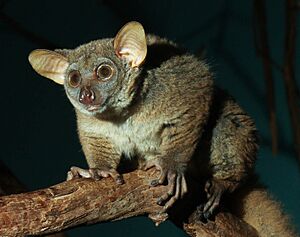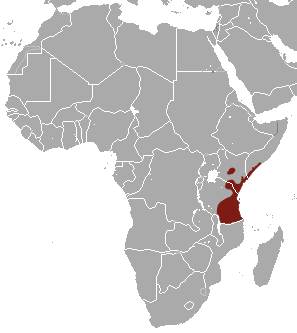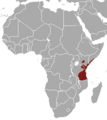Northern greater galago facts for kids
Quick facts for kids Northern greater galago |
|
|---|---|
 |
|
| Conservation status | |
| Scientific classification | |
| Genus: |
Otolemur
|
| Species: |
garnettii
|
 |
|
| Northern greater galago range | |
The northern greater galago (Otolemur garnettii), also known as Garnett's galago, is a type of primate that lives in trees. It's active at night (nocturnal) and is found only in Africa. These amazing animals are sometimes called "bushbabies" because of their cries, which sound like a baby crying.
Contents
Different Kinds of Northern Greater Galagos
Scientists have found four slightly different types, or subspecies, of the northern greater galago:
- Otolemur garnettii garnettii
- Otolemur garnettii lasiotis
- Otolemur garnettii kikuyuensis
- Otolemur garnettii panganiensis
What They Look Like
Northern greater galagos are bigger than many other galago species. They have a round head with a short, wide nose and large eyes that help them see well in the dark. Their ears are quite small compared to their head size.
Fur Colors
Their fur color can change depending on which subspecies they are:
- O. g. garnetti has reddish-brown fur with a hint of green on its back. Its belly is yellow, and the end of its tail is black.
- O. g. lasiotis has lighter, more gray fur. Its belly is white, and the tip of its tail is only a little darker.
- O. g. kikuyuensis has iron-gray fur with a green tint on its back, sides, and legs. Its belly is yellowish-white, and the last part of its tail is usually black.
- O. g. panganiensis is reddish-brown to gray, without the green hints seen in other types. Its belly can be white or yellow, and the end of its tail is dark brown or black.
Size and Weight
These galagos are about 23 to 34 centimeters (9 to 13 inches) long from head to body. Their tails are even longer, usually 31 to 44 centimeters (12 to 17 inches). They weigh between 0.5 and 1 kilogram (about 1 to 2 pounds).
Male northern greater galagos are generally bigger than females. This is because males grow for a longer time. On average, males weigh about 794 grams (1.75 pounds), while females weigh about 734 grams (1.6 pounds).
Where They Live
Northern greater galagos live in the coastal areas of East Africa. You can find them from the Juba River in Somalia all the way down to the Ruvuma River in Tanzania. They also live inland in the Kenyan highlands and on the islands of Zanzibar and Pemba.
They prefer to live in forests near the coast or rivers, or in the highland forests of Kenya. You won't find them in open grasslands or savannahs.
Specific Locations for Each Subspecies
- O. g. garnetti lives only on the islands of Zanzibar and Pemba.
- O. g. lasiotis is found along the coast of Kenya, stretching north to the Juba River and south into Tanzania. It also lives inland in places like the Taita Hills.
- O. g. kikuyuensis makes its home in the Kenyan Highlands.
- O. g. panganiensis is found throughout Tanzania, from the border of Mozambique north to the Tanga region.
Behavior and Diet
Northern greater galagos are active at night and spend most of their time in trees. During the day, they sleep alone in trees. When night comes, they wake up and start looking for food. They often focus on one part of their home area for a few nights, then move to a new spot.
They move on all four limbs, walking and running through the trees. They can also hop short distances from tree to tree. Unlike some other large galagos, northern greater galagos can land feet-first when they leap.
Their diet is a mix of about half fruit and half insects. They are smart enough to learn how to catch fish and eat snails if they can find them.
Territory and Social Life
Northern greater galagos are mostly solitary animals. They live and search for food in their own home areas. They mark their territory using their urine and scent glands on their chests.
Young males and females leave the area where they were born. Males usually leave earlier and travel farther away. Males' territories often overlap with those of several females. However, females tend to be more dominant than males. Females are also more aggressive towards other galagos passing through their territory.
These galagos are not as social as some other types of galagos. This might be because they eat a lot of fruit. It's better for them to keep other unrelated galagos away from areas where there's plenty of fruit. Even so, they still enjoy some social play. Instead of grooming each other, they might lick each other, which helps them stay clean without too much social interaction.
Reproduction and Life Cycle
The mother galago carries her baby for about 130 days before it is born. Usually, a female will have only one baby at a time, though twins are rare.
Mothers carry their babies in their mouths to safe nests in trees. They leave their young in the nest while they go out to find food, returning later to feed them.
Images for kids




